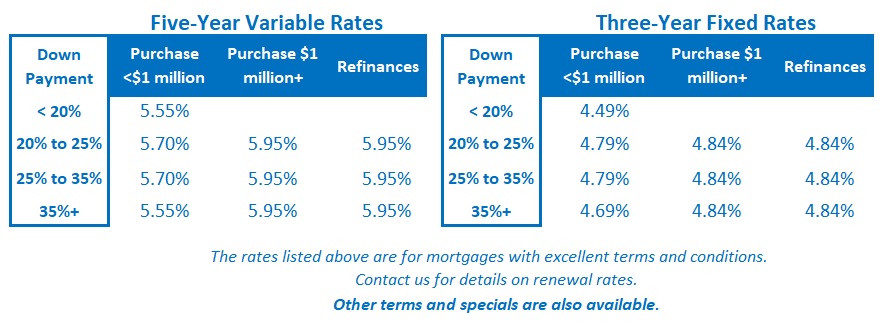Canadian Inflation Falls and the US Fed Pivots
August 26, 2024Thoughts on the Bank of Canada’s Most Recent Rate Cut and Commentary
September 9, 2024 The Bank of Canada (BoC) meets this Wednesday and there is broad consensus that it will cut its policy rate by another 0.25%, lowering it from 4.50% to 4.25%.
The Bank of Canada (BoC) meets this Wednesday and there is broad consensus that it will cut its policy rate by another 0.25%, lowering it from 4.50% to 4.25%.
If that happens, variable mortgage rates will drop by the same amount in short order.
Our fixed-rate mortgages are priced on Government of Canada (GoC) bond yields, and they have already fallen in anticipation of the Bank’s next move. If the BoC’s accompanying policy-rate language is consistent with the consensus outlook, fixed mortgage rates might not move at all.
For my part, I think the only potential surprises would be the Bank sounding even more dovish than expected, with an outside chance that it drops by 0.50% instead of 0.25%.
To be clear, a half-point cut would contradict recent comments by BoC Governor Macklem, who told Canadians to expect policy-rate reductions to occur at a “gradual” pace. But the Bank has also consistently maintained that it “will be guided by incoming information”. On that note, here is a recap of our recent key economic data:
- Our Consumer Price Index (CPI) came in at 2.5% year-over-year in July, and mortgage interest costs accounted for 1.2% of that increase. Given the direct link between the BoC’s policy rate and mortgage interest costs, the faster the Bank cuts, the sooner inflation will return to its 2% target.
- Our GDP increased by 2.1% in Q2 on a quarter-over-quarter basis (q/q), which was better than expected, but it fell by 0.1% on a per capita basis (which is what individual Canadians actually feel). The composition of that growth was not ideal –most of Q2 gain was fueled by government spending (which increased 6.7% q/q).
- Our economy shed jobs in both June and July, and most of the job creation we have seen over the past twelve months has come from the public sector. (Anyone else noticing a theme around government spending here?)
- Our average wage growth is still above 5%. That remains a concern for the BoC, but it is set to fall sharply soon if current trends hold. In fact, wage growth could easily drop back to 2% by the end of the year, due to base effects (which I detail in this recent post).
- Consumer spending has slowed sharply, debt utilization and default rates are rising, and businesses and consumers are both less confident in their future prospects (as per the BoC’s recent surveys of both groups).
By its own estimate, the BoC’s policy rate will continue to restrict economic growth until it is reduced to between 2.5% and 3%, which it considers the neutral-rate range. Bond-market investors now expect it to fall to 3% by next July.
If we return to that level at the “gradual” pace that Governor Macklem’s espouses, the slowing that is now increasingly evident in our economic data will intensify. That will, in turn, increase the odds that the Bank will end up having to drop the policy rate below its neutral-rate range (to compensate for having overtightened, as it had to do in several of its past rate-cut cycles).
In the meantime, the BoC probably won’t cut by 0.50% this Wednesday, but I think they will wish they had when all is said and done.
Mortgage Selection Advice for Now
My overall assessment of our current mortgage-rate backdrop is unchanged.
I think the case for variable rates is compelling, based on my belief that the BoC will likely reduce its policy rate by at least another 1.5% to 2.0% over the next twelve months (give or take). If that forecast proves correct, today’s variable mortgage rates will outperform all the available fixed-rate options, even though variable-rate borrowers have to start out with a higher rate.
With that said, I can’t see around corners any better than anyone else. Unforeseen factors may lead us to a different outcome.
If you prefer the stability of a fixed mortgage rate, I think you are well advised to consider three- or four-year fixed rates today. While five-year fixed rates are the lowest on offer, I worry that five years is too long to lock in at this point in our interest-rate cycle, and the premiums on one- and two-year fixed rates are still too onerous.
Anyone considering fixed-rate options should also pay extra attention to the terms and conditions in their mortgage contract. They vary widely among lenders and can have a surprising impact on the overall cost of your loan, especially if mortgage rates drop significantly during your term.
If you want to learn more about this topic, my post entitled What’s in the Fine Print is a good place to start. It provides a detailed summary of the terms and conditions to watch out for and links to other posts that dive deeper into the most important ones. The Bottom Line: GoC bond yields moved a little higher last week but not enough to put any upward pressure on fixed mortgage rates.
The Bottom Line: GoC bond yields moved a little higher last week but not enough to put any upward pressure on fixed mortgage rates.
Variable-rate borrowers can feel confident that they have another rate cut in store this week, with several more to come at the BoC’s following meetings.
Put me down (grudgingly) for a 0.25% cut this Wednesday.







